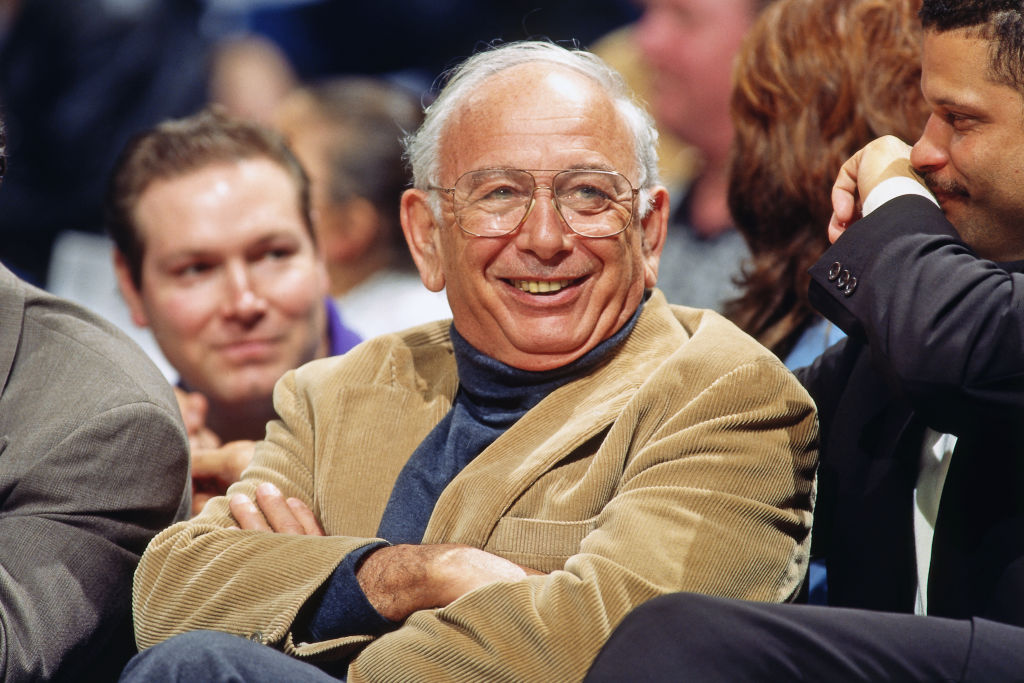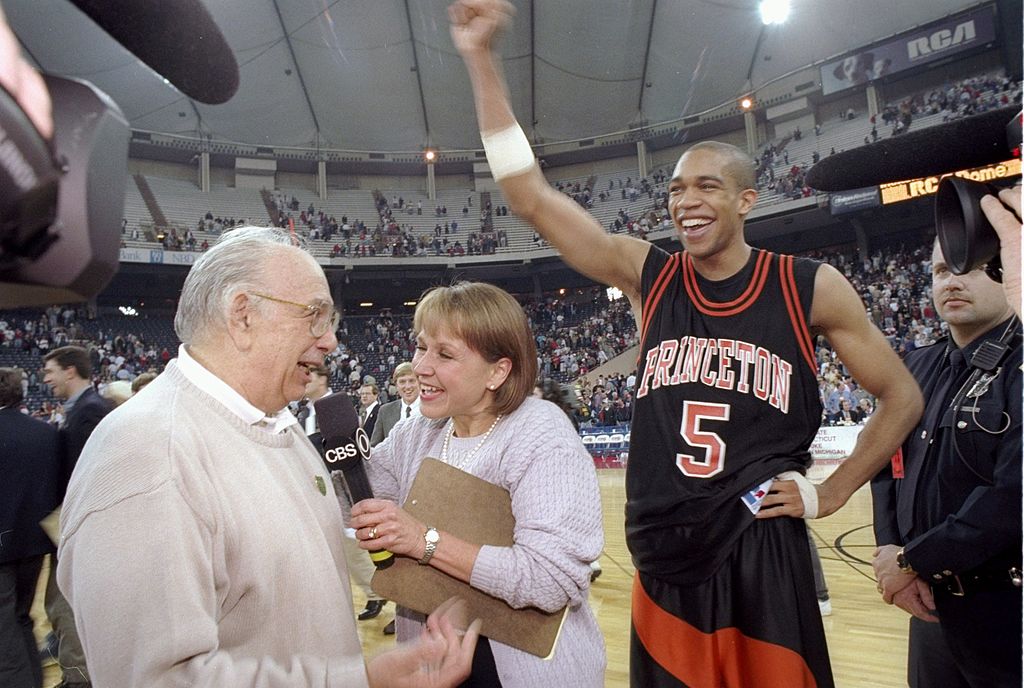
It was the summer of 1994, and my mom popped into my room to deliver a message: Pete Carril was on the phone. I walked out into the kitchen to grab the old landline receiver, nervous about what this conversation could possibly be about, and a bit awestruck that it was even going to happen.
By then Carril, the innovative Hall of Fame basketball coach who died, at 92, on Monday, was known throughout the hoops world as a near-slayer of giants: five years prior, on St. Patrick’s Day, his 16th-seeded Princeton team put a scare into top-ranked Georgetown Hoyas in the first round of the NCAA tournament. Princeton lost, 50-49. But at a time when the college basketball powers-that-be were considering eliminating automatic March Madness bids for the small conferences, the Georgetown-Princeton game restored faith in Cinderella’s charm. It was the highest-rated hoops game in the history of ESPN. The little guys kept their spots and CBS bought the rights to the whole NCAA tournament. The NCAA men’s basketball tournament is now an $8.8 billion enterprise, and the March office pools a national pastime.
I now had a chance to be a part of all this. Carril recruited me to play for Princeton very late in my senior year of high school, and I’d be heading down to New Jersey come fall. There was one problem, the subject of this phone call: at 6’3″, 155-pounds, my dimensions were not optimal for banging under the boards with, say, former Georgetown center Alonzo Mourning, who willed the Hoyas to victory over Princeton back in 1989. Forget Mourning: those dimensions weren’t ideal for going up against 99% of Division 1 players. I needed to put on weight, fast, and Carril was calling to make a very specific suggestion.
“Yo, Sean, here’s what you need to do to get bigger: drink a six-pack of beer and eat a ham sandwich, before bed, every night. Got that kid?”
I laughed. Carril didn’t. He was deadly serious.
Up to this point, I had known Carril only as so many people from the outside viewed him: as the Yoda-like sideline genius whose deliberate style of play, which emphasized passing and movement and more passing until a worn-down defense gave up an easy shot, enabled an undersized team like Princeton to hang tight with Georgetown, Arkansas, Villanova, and Syracuse in four straight NCAA tournaments from 1989-1992. As I’d soon discover, Carril was so much more. What he lacked as a nutritionist or a purveyor of modern-day “load management”—all his starters often played nearly 40 minutes a night—he made up for in viewing the game, and life, in the maddeningly effective terms of a pop philosopher. See what’s around you. If you can’t see, you can’t do. Share the ball. If you’re closely guarded, go backdoor. Don’t spend too much time reflecting on the past, because what does that really do for you in the moment, and in the future?
Michelle Obama’s brother, Craig Robinson—1982 and 1983 Ivy Player of the Year at Princeton—had Carril in mind when inviting her new boyfriend, Barack, to a pickup game in Chicago in order to size him up. If a guy is an a–hole on the basketball court, he’s probably an a–hole in real life. This Obama guy, Craig knew after playing with him, was all right.
Carril abhorred new-age tools. “He didn’t understand computers or the people who used them,” says Bill Carmody, Carril’s longtime assistant at Princeton, who succeeded him at the school and went on to coach at Northwestern and Holy Cross. But going back to the 1970s, Carril foresaw analytics before anyone—especially him—even knew what that term meant. His Princeton teams were essentially basketball’s version of the Moneyball Oakland As. While finances constrained the small-market Oakland from competing with the New York Yankees for high-priced baseball talents, Princeton’s strict admissions requirements, and lack of athletic scholarships, constrained the Tigers from signing All-American recruits. So Carril had to look elsewhere for competitive advantages. He found it, in an offensive designed to secure two of the most efficient ways of scoring: open three-point shots, and easy backdoor layups. He prized players, overlooked by most big-time schools, who could hit open threes and throw crisp passes for those two-point shots. Princeton’s teams almost never took contested mid-range two-point shots. Those attempts were inefficient; their smaller players were better off shooting further away from the stronger defenders. Plus, those shots were worth another point. Carril’s math added up.
Once Carril left Princeton in 1996 after 525 career victories in 29 years there and one year at Lehigh —his last college win was a memorable 43-41 victory over UCLA that secured his spot in the Hall of Fame, and whose winning basket, a signature backdoor layup, plays on a highlight loop every March—he brought his philosophy to the NBA, as an assistant to the Sacramento Kings. In 2002, Carril’s Kings nearly met the New Jersey Nets in the NBA Finals; Nets head coach Byron Scott was also an assistant with Sacramento in the late 1990s, and he installed some of Carril’s passing concepts with New Jersey, who at the time employed the best passer in the game, Hall of Fame point guard Jason Kidd. A 2017 Wall Street Journal article pointed to Carril’s continued influence in the NBA: like Princeton, teams like the champion Golden State Warriors seek out efficiency through valuing the three-point shot, easy layups, and eschewing mid-range two-pointers.
Warriors general manager Bob Myers was a reserve on the UCLA team that lost to Princeton in 1996 (I was also a reserve in that game, for the Tigers. Myers outplayed me, 4 minutes to zero.) He’s seen Carril’s influence up close. “I will never forget losing to Pete’s Princeton Tigers my junior year at UCLA,” says Myers. “His team’s back door cuts and passing out of the high post are something that the Warriors and the entire basketball world has benefitted from.”

‘You’ll Miss’
When I got to Princeton, I also soon learned Carril wasn’t for everyone. Upon his retirement from Princeton back in 1996, he admitted he was “a little too rough, too severe” for a then-younger generation. The son of a Pennsylvania steelworker, Carril held the privileged background of some players against them, even if they didn’t completely deserve such animosity. Many were just trying to succeed at basketball. He drove some players to quit, and in quieter moments in later years, would admit he’d handle some relationships differently.
But damn if he wasn’t entertaining. One of our players threw an errant pass in practice that cracked Carril’s glasses. He ripped his shirt off in anger, exposing tufts of gray chest hair. His crooked frames stayed on his face the whole time, and the drill resumed. He smoked cigars during practice: the indoor track teams who shared the gym with us had to sprint through the stench. Carril once told a player he planned to write the word “layup” across his own chest. He’d dare the player to punch him. “You’ll miss!” he screamed.
Carril, who was a “Little All-American” at Lafayette College in the early 1950s often played basketball at lunchtime, well into his 60s. He had a funny set shot that somehow went in more often than not. During one game, a football coach blew out some ligament and was writhing in pain.
Carril sauntered over to him. “I suppose,” he said, “this is a bad time to tell you you traveled.”
He asked a friend about a prospective recruit. The friend told him that many respected scouts said the player had a bad summer. Carrill leaned back in his chair and took a puff of his cigar. “Frankie,” he said, “we play in the winter.” He wanted our biggest player to get faster. So he had him chase around our smallest player around the court for about a half hour. “Catch him!” he’d yell. “CATCH HIM!!!”
Before or after many practices, he’d go “down the line,” pointing out the fatal flaw of each and every player, in front of everyone else. This exercise often involved ranting and raving and colorful language. When I was helping coach my son’s 7th-grade basketball team a few years back, in a private moment with him I channeled Carril, and acted out what he would probably say about each of his 12-year-old teammates—and him. He laughed.
And damn if he wasn’t right about a lot of stuff. Focusing on the past is largely counterproductive. Failing to take a charge, or dive after a loose ball, is probably a character flaw. All that takes is some bravery. He’d add five-to-10 feet to a player’s shooting range by encouraging him to shoot the ball while rising in the air, instead of at the peak of the jump. You get more leg strength that way. (Stephen Curry never played for Carril. But he shoots like that).
After Princeton’s current coach, former Tiger player (and teammate) Mitch Henderson, was hired for the job in 2011, Carril handed him a card. It said, “Think. See. Do.” Carril stared at him for five seconds. “It felt like 30,” Henderson says. “It was one of those, ‘are you f-cking listening?‘ looks.” Message received. He’s won 63% of his games at the school.
And he was probably right about my diet. I tried the ham and cheese and six-pack combo once or twice, but it didn’t really sit. I never really put on enough weight to be a serious college player. But I can trace most good things in my life—friends, wife and family, occupation—to Carril’s decision to give me a shot. He labeled me “Bones” my freshman year, and it stuck. I swear some friends and classmates still don’t know my real name. And while that’s not a great name for a wanna-be hoops player, I’d love to try to get away with it come middle age.
Thanks, Coach.
More Must-Reads from TIME
- Cybersecurity Experts Are Sounding the Alarm on DOGE
- Meet the 2025 Women of the Year
- The Harsh Truth About Disability Inclusion
- Why Do More Young Adults Have Cancer?
- Colman Domingo Leads With Radical Love
- How to Get Better at Doing Things Alone
- Michelle Zauner Stares Down the Darkness
Write to Sean Gregory at sean.gregory@time.com